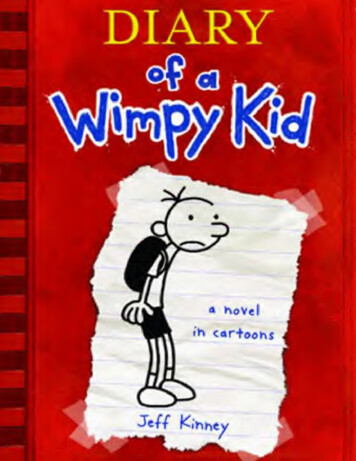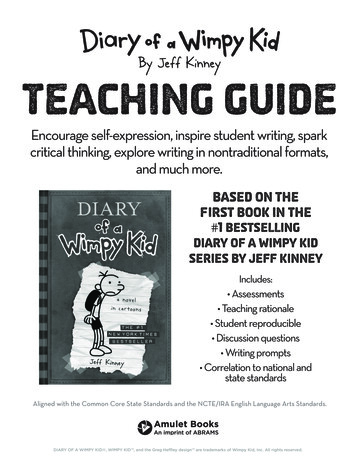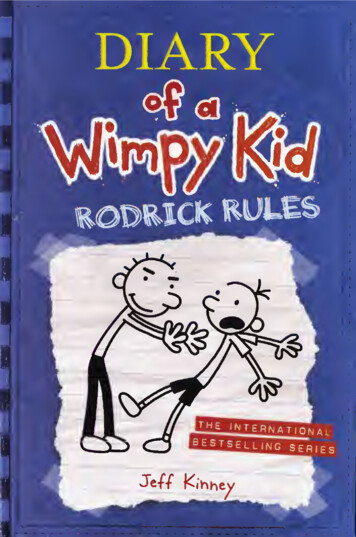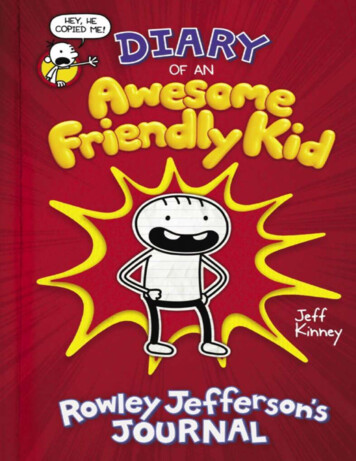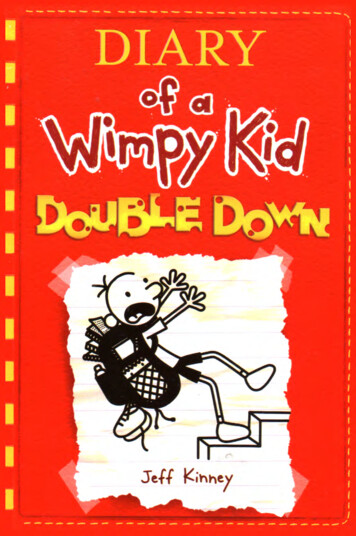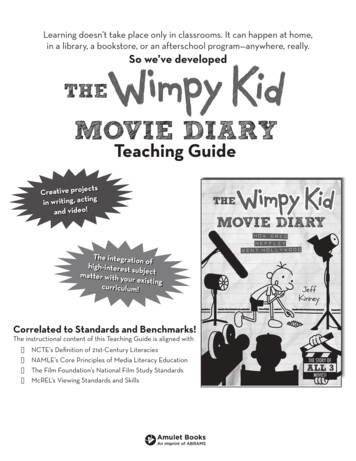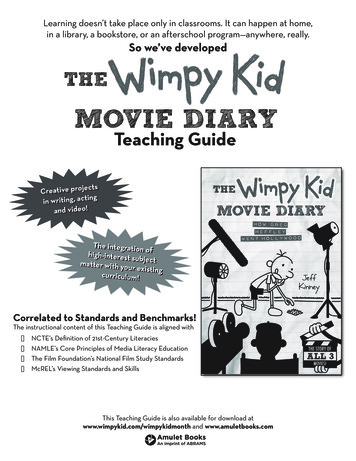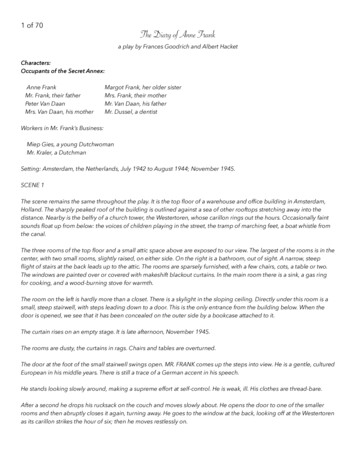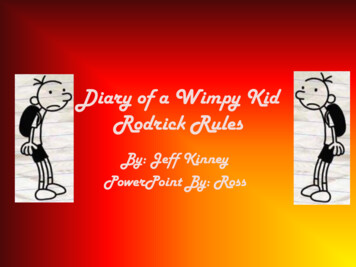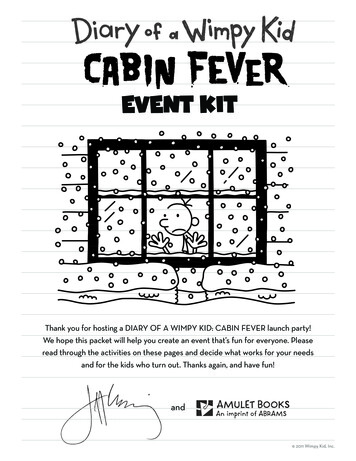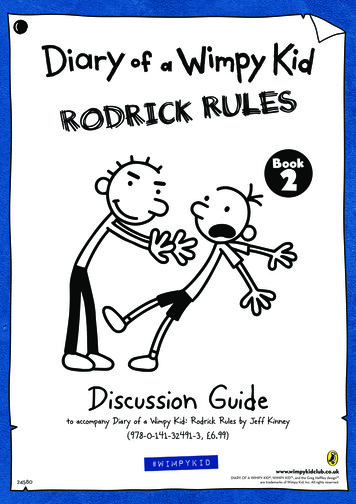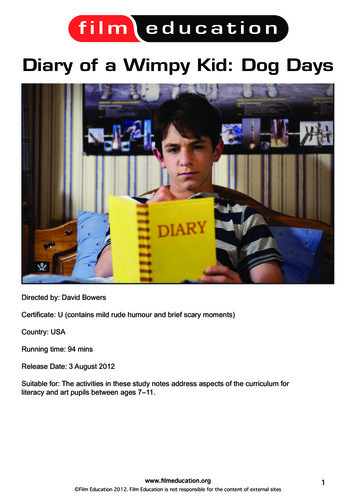
Transcription
Diary of a Wimpy Kid: Dog DaysDirected by: David BowersCertificate: U (contains mild rude humour and brief scary moments)Country: USARunning time: 94 minsRelease Date: 3 August 2012Suitable for: The activities in these study notes address aspects of the curriculum forliteracy and art pupils between ages 7–11.www.filmeducation.org Film Education 2012. Film Education is not responsible for the content of external sites1
SynopsisIt’s summer vacation time and Greg pretends to have a part time job so he can get out of a realone. However, his summer plans lead to a series of embarrassing situations visiting the localswimming pool, learning to play tennis, camping with his dad and taking care of his new dog,Sweetie. Will he ever win the heart of his school crush Holly Hills? His best friend Rowley andbrothers Rodrick and Manny join him for the ride once again.GenreThis is the third comedy based on Jeff Kinney’s bestselling series of cartoon novels about a normalboy’s struggles to become popular in school. Diary of a Wimpy Kid: Dog Days is based on the thirdand fourth books in the series, The Last Straw and Dog Days. Greg, the main character, narratesthe film and Jeff Kinney’s well-known cartoon style is used during the credits and throughout thefilm.Before seeing the filmJeff Kinney’s books are hugely popular. Who in the class has read them? What can they tell theothers about them? Ask pupils who have read the books to give a short presentation about theirfavourite in the series.As a class, look at the illustrations in the original books. Jeff Kinney has a simple but very uniquecartoon style. Become illustrators and try drawing Greg and other key characters. Then challengeyourselves to draw each other in Jeff Kinney’s style.Learn more about book to film adaptation and try the tasks at Film Education’s online resource forthe first film: www.filmeducation.org/diaryofawimpykid/Have a look at the film’s poster in this guide. Compare with the posters from the previous two filmsin the series and discuss the following questions:What’s the first thing on the poster that grabs your attention? Which characters are on the poster and why do you think they were chosen? How have Jeff Kinney’s illustration’s been used and to what effect? What can you tell about the characters and the story just from the poster? What questions does the poster leave you asking about the film? What kind of person might be interested in this poster and film? What other important information can you see? Where would be an effective place to put this poster?Watch the trailer for Diary of a Wimpy Kid: Dog Days on Film Education’s Teaching Trailers 2012DVD. Discuss how images, soundtrack and words are edited to tease the story and draw-inaudiences. Sign up for a copy of the DVD here e website also provides questions and activity ideas and the ‘Make a Trailer’ feature allowspupils to combine clips, music and text to create their own persuasive teaser trailers for the film.You can watch the trailer for the first film here: cation.org Film Education 2012. Film Education is not responsible for the content of external sites2
www.filmeducation.org Film Education 2012. Film Education is not responsible for the content of external sites3
www.filmeducation.org Film Education 2012. Film Education is not responsible for the content of external sites4
AFTER SEEING THE FILMwww.filmeducation.org Film Education 2012. Film Education is not responsible for the content of external sites5
AFTER SEEING THE FILMWhat is pupils’ top tips for avoiding trouble at school and boredom during the school holidays?Ask pupils to start writing a diary about their school days and holidays, just like Greg. Beginin class by writing a diary entry about the class trip to the cinema and then continue over theweekend and during the next school break. Pupils can illustrate their diary in a similar style toJeff Kinney.Read school survival tips written by pupils from around the country at Film Education’s resourcefor the first film in the k up a whole new embarrassing situation for Greg and write your own ‘Wimpy Kid’ stories.Include a dilemma that Greg has to deal with and an important decision for him to make.Remember to make it funny! For inspiration watch the clips at Film Education’s online resource forthe second film in the psRead the blurbs for the remaining books in Jeff Kinney’s series. Which one are pupils mostexcited to see as a film? Become film producers and create posters for the next adaptation. Readthe next book in the series as a class. Storyboard a persuasive film trailer that teases the story likea blurb and features the funniest moments to convince audiences they should see the film.www.filmeducation.org Film Education 2012. Film Education is not responsible for the content of external sites6
Shot, pair, share – Activity oneNB Teachers: this shot-pair-share activity is intended for before you visit the cinema. However, ifyou have already seen the film, the activity can be adapted with children creating alternate scenesto go with this moment from the film.ShotExplore this film still for clues about the story and talk about it for five minutes. In pairs, discussthe following questions about setting and characters: What is happening in this scene? Where are they and what is it like there? What can you tell about the characters from this image?Success criteria:MUST: talk about what characters are doing and where they areSHOULD: discuss what the facial expressions tell usCOULD: consider what sounds you might hear in this scenewww.filmeducation.org Film Education 2012. Film Education is not responsible for the content of external sites7
PairThis scene features Greg, Rowley and Fregley telling scary stories around the campfire. Eachcharacter has a very different personality. Greg – lazy, impatient, selfish Rowley – immature, naïve, easily frightened Fregley - peculiar, filthy habits, tells disgusting storiesImagine the scene and rehearse possible dialogue between characters. Write a script for thescene. Consider what sound effects you might need. Pairs can join together as a four and practiceperforming their scripts with one group member creating the sound effects.MUST: make it clear who is speaking at each point in the scriptSHOULD: use stage directions and punctuation to show actors how to speakCOULD: use full range of playscript featuresShareWhat happens next? Spend time talking to your pair about what might happen later in this sceneor the next. Script and storyboard the rest of the scene, or the next scene – you could use JeffKinney’s style to help you draw each frame of your storyboard. Think about when you will want touse close-ups to show emotion on faces, mid-shots to show characters interacting or long shots toestablish or re-establish the scene.Success criteria:MUST: use different shot typesSHOULD: consider sound effects and musicCOULD: think about lighting and the length of each shotNB Teachers: Groups of four could develop their scripts and storyboards and perform theirscenes to the class before building them into a longer written story with a dilemma.Written by Matt Poytonwww.filmeducation.org Film Education 2012. Film Education is not responsible for the content of external sites8
Storyboard templateSHOTDIALOGUE / DESCRIPTIONwww.filmeducation.org Film Education 2012. Film Education is not responsible for the content of external sites9
boy’s struggles to become popular in school. Diary of a Wimpy Kid: Dog Days is based on the third and fourth books in the series, The Last Straw and Dog Days. Greg, the main character, narrates the film and Jeff Kinney’s well-known cartoon style is used during th
